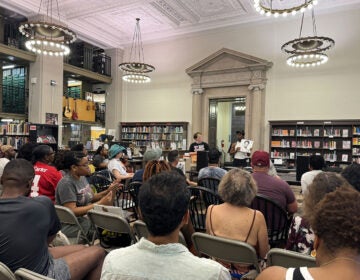Mac or PC? ENIAC helped pave the way for both
On February 14, 1946, America’s love affair with the computer began.
That is when John Mauchly and J. Presper Eckert of the University of Pennsylvania unveiled the Electronic Numerical Integrator and Computer (ENIAC) to the public.
It was commissioned by the U.S. Army, to be able to compute the trajectory of firing shells during World War II, but it was never used for that purpose. The war was practically over by the time ENIAC was operational. After the war it was moved to Aberdeen Proving Grounds in Maryland, where it was used for Army applications.
Although ENIAC was not, technically, the first electronic computer, it was the first electronic computer that could be custom-tailored to compute anything. It represented a milestone for both modern computing and the military-industrial complex.
Previous electronic computers were designed for a single task – for example, cracking enemy codes. ENIAC’s claim to fame was its speed – it was three thousand times faster than its predecessors – and versatility.
It was comprised of 40 racks, each about eight feet high and two feet wide, filled with a total of 18,000 vacuum tubes. It was the size of a very large room. Programmers had to re-wire the entire machine for each application. The women programmers (and they were mostly women, trained as mathematicians) would create a complex web of wires like an old-fashioned telephone switchboard.
“Originally they thought people would set up their own programs, and the ENIAC programmers would just set the swtiches,” said Jean Bartik, 85, one of the original “computers.” “But it turned out that from the very beginning that it was too complex for people to set up their own programs. So they didn’t do it.”
Bartik says she applied for a job with ENIAC because she studied math in college but dreaded the idea of teaching schoolchildren. She is featured in the new documentary film “Top Secret Rosies”, about women computers during the war.
Other computing machines used during the war were destroyed, lest the technology fall into enemy hands. Not so with ENIAC. Unveiling it to the public was the point.
ENIAC was expensive to build – almost half a million dollars in 1946 – far too much just to create firing tables for heavy artillary guns. President Roosevelt and the U.S. Army had to justify the exorbidant expense.
“It was the first time in the history of the country of taxpayer money being used for research at the frontier, which was risky and no one wanted to pay for,” said Joe Bordogna, former dean of the Moore School of Electrical Engineering at the University of Pennsylvania. “That knowledge entrepeneurs could take and put it into the marketplace.”
ENIAC itself never went commercial. But it’s creators, Mauchly and Eckert, went on to create UNIVAC, the first programmable compter designed for business applications. They knew they were on the cusp of the future.
“The thing nobody thought of was the miniaturization of the circuitry, that computers would be as cheap as they are,” said Bartik, who left ENIAC to work on UNIVAC with Mauchly and Eckert. “We thought things would get bigger, more powerul. We never dreamed they would be tiny little things they are today.”
Today, a portion of the original ENIAC is on display in a student lounge at Penn’s electrical engineering school. The faces of international students sitting at tables are illuminated by the glow of their laptops, each thousands of times faster and smaller than the grandaddy of them all, a black, hulking thing about the size of a refigerator behind museum glass. That thing is just one-tenth of the entire ENIAC. Other pieces are scattered at institutions around the country.
“Top Secret ‘Rosies’: The Female ‘Computers of WWII” will be shown on Wednesday, March 2, at 7:30 p.m. at the Bryn Mawr Film Institute followed by a question and answer session with filmmaker LeAnn Erickson. Admission is free of charge.
WHYY is your source for fact-based, in-depth journalism and information. As a nonprofit organization, we rely on financial support from readers like you. Please give today.




